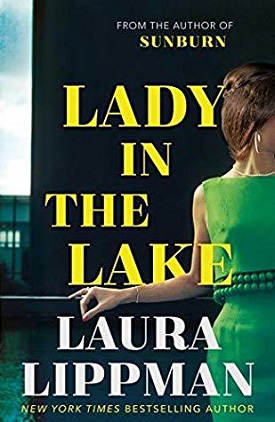 Synopsis:
Synopsis:
Lady in the Lake, set in 1960s Baltimore, is a stylish thriller combining modern psychological and sociological insights with elements of classic noir.
In 1966, Baltimore is a city of secrets that everyone seems to know — everyone, that is, except Madeline “Maddie” Schwartz. A year ago, she was a happy, privileged and pampered housewife. But she has bolted from her stale, predictable marriage of almost twenty years, determined to make good on her youthful ambitions to live a passionate, meaningful life. Now she’s a former housewife and mother turned aspiring reporter pursuing the killer of a forgotten young woman.
Maddie wants to matter, to leave her mark on a swiftly changing world. Drawing on her own secrets, she helps Baltimore police find a murdered girl — assistance that leads to a job at the city’s afternoon newspaper, the Star. Working at the newspaper provides Maddie the opportunity to make her name and she believes she has found the story that will propel her into a successful career: a missing woman whose body was discovered in the fountain of a city park lake.
Cleo Sherwood was a young black woman who liked to have a good time. No one knows or cares why she was killed — except Maddie and the dead woman herself. While Maddie is determined to learn the truth about Cleo’s life and death, Cleo’s ghost, privy to Maddie’s poking and prying, wants only to be left alone.
Maddie’s investigation brings her into contact with people who used to be on the periphery of her life — a jewelry store clerk, a waitress, a rising star on the Baltimore Orioles, a patrol cop, a hardened female reporter, and a lonely man in a movie theater. But despite her ambition and drive, Maddie often fails to see the people right in front of her. Her inability to look beyond her own needs leads to tragedy and turmoil for all sorts of people — including the man who shares her bed, a black police officer who cares for Maddie more than she knows.
Review:

Acclaimed, best-selling author Laura Lippman uses a real-life unsolved drowning as the springboard for her new thriller, set in Baltimore in the turbulent mid-1960’s.
The world is changing rapidly. Societal norms are being challenged. And thirty-seven-year-old Maddie Schwartz is no longer content to sit on the sidelines in her comfortable home with her dull, but reliable husband, Milton, and seventeen-year-old son, Seth. Maddie did what was expected of her — she married an attorney, keeps a kosher home, cares for her son, and hopes that no one ever finds out about the dark secret she harbors. Before she married Milton, she did not always conform.
When Milton brings home the local television reporter — a man Maddie knew in high school — something snaps and she realizes she needs to pursue the dreams she abandoned in favor of stability and acceptance. She leaves Milton, and rents an apartment downtown in a neighborhood that is suffering the ravages of “white flight” to suburbia. Seth refuses to join her there. And one day, the always-clever Maddie devises a scheme to improve her circumstances that has far-reaching consequences she could never have anticipated.
Are you really missing if nobody misses you?
Meanwhile, the body of a young woman lies submersed in the fountain situated in the park surrounding a local lake. She is a missing person that no one is actually looking for, a young African-American woman who left her two young sons, fathered by two different men, with her parents to raise while she worked in the notorious Flamingo Club, tending bar and performing other duties better left unmentioned. She visits her sons and parents, brings them gifts, and leaves again, much to the dismay of her mother and father.
When Maddie and a friend discover the body of missing eleven-year-old Tessie Fine, she schemes to find a way to parlay her luck into a job as a reporter at the Baltimore Star. She gets a job — as the assistant to the Mr. Helpline columnist — but will not be satisfied until she reaches her goal. She understands all too well that men control her destiny and will use any means necessary, including flirtation and the trust of those who provide her tips, to achieve her goal. “Women . . . learned early to surrender any idea that life was a series of fair exchanges. A girl discovered almost in the cradle that things would never be fair,” Maddie observes.
Lippman knows Baltimore. She spent 12 years as a reporter at the Baltimore Sun. Ironically, she says that she didn’t set out to write a book in which much of the action is focused around a newspaper, noting that “Maddie Schartz surprised me as much as she surprised her longtime husband.” Lippman soon found herself interviewing her father’s colleagues — Theo Lippman Jr. was a journalist at the Baltimore Sun beginning in 1965 — in order to get the details just right. Indeed, Lady in the Lake is replete with historical and geographical references not just to the era, but Baltimore specifically. She even includes two real people as characters in the book: the first African-American police officer in Baltimore, Violet Wilson Whyte who was known as Lady Law; and Orioles centerfielder Paul Blair.
The story is told by a series of narrators, primarily the lady in the lake herself and Maddie. Chloe’s ghost is acerbic and bluntly frustrated by Maddie’s determination to find her killer, warning Maddie, “You’re going to hurt people if you don’t stop this. Maybe even yourself.” Chloe has her own opinions about the state of women in 1965 Baltimore: “A woman is only as good as the man at her side.” As Maddie encounters other characters, they are called upon to narrate the next chapter. Some reoccur, some only briefly contribute to the plot’s progression. Lippman uses their voices to great effect to supply historical significance, context, and perspectives that balance Maddie’s increasingly obsessive, and at times quite selfish, quest for the truth. Through her eclectic group of storytellers, Lippman explores not just the two killings, but racism, classism, and sexism, as well as the price that unbridled ambition can extract — especially from a woman. Maddie laments, “The men made the rules, broke the rules, and tossed the girls away.” But Maddie is determined not to suffer the same fate.
Maddie is a fascinating, if not always empathetic character. She readily admits that she doesn’t know herself and struggles to reconcile the values and social mores with which she grew up with her life as a Jewish-American housewife. More confusing are the dramatic and often suffocating differences between the world she experiences as a woman on her own for the first time and the world she wants to inhabit: a world in which women are not invisible and practically disposable. Her obsession with Chloe and determination to find out who killed her, and why, is fueled by her consternation over the fact that no one else appears to care. Maddie is convinced that the murder should be front page news, declaring, “I’m going to write about her. A woman is dead. Maybe I can make people see that they should care about that.” But her white male coworkers at the Star repeatedly try to dissuade her from pursuing the story. As one reporter tells her, “They’re not big stories, the colored dying. I mean, it happens all the time. It’s the opposite of news. Dog bites man. Plus, you heard the medical examiner. Probably drugs. She got high and decided she could swim to the fountain.” And as Chloe observes, “Tessie Fine — she was missed right away. I know, I know: she was only eleven. And white. Still, it did not escape my attention that her disappearance was noted almost immediately.”
Lady in the Lake is a sophisticated, absorbing, and eerily timely tale about a time and place not all that long ago that will leave readers pondering how much, if at all, America has changed in the intervening years. And, perhaps just for good measure, Lippman ends it with a shocking and clever plot twist most readers will never see coming.
Also by Laura Lippman:
Stand-Alones
Tess Monaghan Novels
Enter to Win a Copy of Lady in the Lake
NOTE: The book may only be mailed to a United States address.












12 Comments
I have read all of Laura Lippman’s novels which are captivating, intriguing, and unique. The Tess Monaghan novels are my favorite of all.
I haven’t read anything by her before but I’m interested in this book for sure! The fact that she left all she’s known for 20 years to find her true passion and herself makes it all that more interesting to me
This would be my first book by her, but, thriller, noir, etc….that’s right up my alley.
I have loved the two books I have read by Laura Lippman. So far I’ve read “After I’m Gone” and “What the Dead Know.” Both kept me wildly entertained and turning the pages. I liked that I really did not see the resolution coming in “What the Dead Know.” It was really good but also heartbreaking to read.
Are you really missing if nobody misses you?
This line alone makes me want to read it!
I haven’t read any of Laura Lippmann’s other books, but this book intrigued me as it deals with social issues as well as being a psychological thriller.
I loved Sunburn! I’m looking forward this new one!
Thank you for the chance to read my first Laura Lippmann book.
Lady in the Lake sounds like the type of Historical Suspense novel that I really enjoy. Twists and turns and a lot of questions to be answered
Love historical books. New author for me.
I have read only one book by Laura Lippman, but I look forward to reading more soon! Thanks for the giveaway!
Have read many of her books. Love Tess, Sunburn most recently.